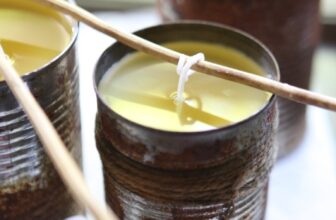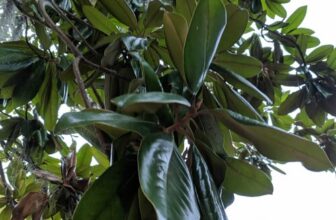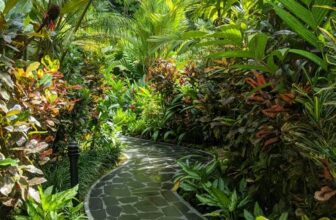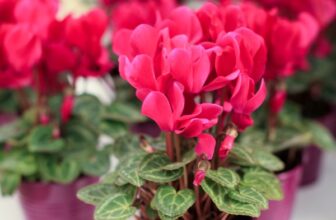Discover why leaving seedheads standing in your garden can transform your garden through winter, help wildlife and minimise your work in the garden. From sculptural alliums to delicate grasses and wildlife-friendly teasels, the best plants for seedheads add texture and interest long after the flowers fade.

Gravetye Manor gardens in late January – hydrangeas are one of the best plants for seedheads
However, it’s rare that seedheads are mentioned when you’re choosing and buying plants.
Last month, I nearly pulled out my statuesque Verbascum, whose yellow summer flowers had turned into dark brown spikes. Then I saw a tiny sparrow pecking at the seedheads. It reminded me that, although I often say “leave the seedheads”, I still sometimes reach for the secateurs too soon.
Last year we deliberately left the main border standing until early spring—and we’ll do it again this year. The slowly collapsing foliage protected roots and wildlife. Much of it rotted down naturally to enrich the soil, and best of all, the seedheads looked beautiful in the low winter sun and frost.
Why you should leave seedheads over winter
An increasing number of professional gardeners recommend leaving borders untouched until early spring. There are several good reasons for this:
- Wildlife benefits: birds feed on seeds and insects shelter in the stems or under fallen foliage.
- Soil protection: decaying plant matter helps insulate roots from frost and breaks down to improve soil structure.
- Less work overall: much of the material breaks down naturally by early spring. You’ll have less to clear away.
- Winter beauty: seedheads create sculptural silhouettes in sunlight, mist or frost.
Not every plant has good seedheads, of course—and not everyone likes the look of a fading garden. But maybe it’s time to see that seedheads have a beauty and elegance of their own, especially if the alternative is leaving the borders empty and silent.
An increasing number of top professional gardeners, including the RHS, now advise people to leave leaves in their borders for much the same reasons. Read when you should Leave the Leaves here.

We left our main border to gently collapse over winter. I like the ethereal effect in frost.
When even the best plants for seedheads can be TOO much of a good thing!
Leaving seedheads means you will get more self-seeders. These volunteers can fill gaps beautifully (see 25 Best Self-Seeding Plants), though some need regular weeding out. However, I always say that it’s easier to pull a plant out than it is to buy one, then plant it.
But some self-seeders can be invasive.
It’s important to distinguish between non-native and invasive plants. A plant may come from another region without being invasive—but check what’s invasive in your area before you let it spread. What’s harmless in my garden might be a problem in yours.

Non native is not always the same as invasive. But English ivy is an important source of food and shelter for UK wildlife, yet it’s invasive in some parts of the US.
It’s also important to check reliable sources for information on what is invasive in your area. When you put ‘is X Plant invasive in my area?’ into a search engine, go to the results from universities, botanic gardens, well known organisations – such as the RHS – or government websites.
The general AI round-up at the top of the search results takes information from a wide range of sites. Not all are scientifically or horticulturally accurate. So AI round-ups often contain factual mistakes, known as ‘hallucinations’. (I still haven’t recovered from AI telling me the wrong station was nearest to a friend’s house on a baking hot day!)
I have photographed all the plants you see here in my own garden, in friends’ gardens or in the gardens of top professional gardeners. When checking names and facts, I try to use only the best botanic websites, and I double-check where I can.
The Best Plants for Seedheads
Here are some of the best plants for seedheads—chosen for beauty, wildlife value, and structure through winter.
Acanthus mollis (Bear’s Breeches)
The white form Rue Ledan has dramatic seed spikes that stand tall through winter. Native to southern Europe and North Africa, hardy to –17°C/0F.
The more common Acanthus mollis has a purple stripe in its flowers. This one can be very invasive in many areas, so check before planting.

This variety of Acanthus mollis is called ‘Rue Ledan’ and it isn’t invasive. However, the regular Acanthus mollis can be very invasive in some areas, so check!
Achillea (Yarrow)
Named varieties such as Achillea ‘Moonshine’ produce stronger, longer-lasting seedheads than the wild form, according to my flower farmer friend, Sue of Country Lane Flowers.
Different species are native across Europe, Asia and North America. It’s drought-resilient and named as a top plant for pollinators in the RHS’s list of the best pollinator plants.

This achillea came from a mixed pack of seeds grown by my flower farmer friend, Sue. See her tips for Sowing from Seed here.
Allium christophii
Its large, star-shaped seedheads are sculptural and can even be sprayed gold for Christmas decorations. Hardy to –28°C/-20F. Native to Asia and the Middle East and not usually considered invasive although some other varieties of allium can be very invasive indeed. Check where you are.
My other alliums have usually collapsed by autumn but this one holds its shape beautifully.

Allium Christophii has a big star seedhead which keeps its shape longer than many other alliums. Seen here with Hylotelephium (formerly Sedum) ‘Matrona’ which also has beautiful seedheads.
Anaphalis margaritacea (Pearly Everlasting)
A white, fluffy seedhead loved by flower arrangers. Adds softness to borders or dried displays. Anaphalis varieties are both native to Asia and North America. It spreads easily. Very easy care and hardy down to -40C/-40F.

Anapholis or Pearly Everlasting, a fluffy white seedhead popular with florists.
Asters (may now also be known as symphyotrichum or erybia)
Asters are the common name for a group of daisy-like flowers which are sometimes not related to each other. But everyone knows what you mean when you say ‘aster’.
Some are native to Europe, others to the Americas or Asia and many are very hardy – down to minus 40C/minus 40F. The daisy-like flowers can be blue, white or yellow and they’re a favourite with pollinators as well as having clumps of distinctive seedheads.

Here are the seedheads of a clump of Aster amellus ‘King George’ in my garden. In late summer, these have brilliant blue flowers.
Eryngium (Sea Holly)
One of the very best seedheads—spiky, metallic, and architectural. Thrives in well-drained soil and attracts pollinators and birds. Hardiness varies, but some are hardy down to –28°C/-20F.

Sea holly makes beautiful seedheads, but it doesn’t come back in my garden because although it loves our dry summers, we’ve had some very wet winters, which it doesn’t like.
There are several different varieties around the world. The Europe and Asian native eryngiums are drought resilient, but the North American natives are good in damp areas.
Eryngium is listed as one of the best plants for wildlife by eco-friendly plant specialists, Beth Chatto Gardens.
Foxgloves (Digitalis)
Self-seeding biennials with statuesque spikes. I let them self-seed around my garden. Native to the UK, though invasive in North America.

This is a foxglove seedhead in my garden.
Hydrangeas
There are many different types of hydrangea, with hundreds of varieties in each type. Some – but not all – have striking dried flower heads in gold and bronze tones. The old blooms protect next year’s buds from frost, so don’t cut them until spring.
Some hydrangeas are native to the Americas and others to Europe and Asia. I haven’t found any invasiveness issues and they don’t seem to self-seed. And while most plants with seedheads are valuable to wildlife, many hydrangeas have limited wildlife value in the garden. But we can have plants just because we like them!
See my Really Easy Guide to Pruning Hydrangeas when you do cut the flowers off.

Hydrangeas are one of the best plants for seedheads and they look beautiful in frost. Hardiness varies but some down to -40C/-40F.
Linaria (Purple Toadflax)
Technically a weed, but it adds vertical interest with slender brown spikes in winter and blue flowers in summer. Hardy to –34°C/-30F; check invasiveness where you are.
Liquidambar styraciflua (American Sweetgum)
A tree with bright green spiky seedballs that hang on all winter. They make a beautiful contrast with its red autumn leaves.
Native to the USA and not generally considered invasive elsewhere. Hardy down to minus 28C/minus 20F. However, it can grow tall, so if you have a small garden, be prepared to get a good tree surgeon to keep it both in shape and in check. See Top Tips For Trees – What You Need to Know Before You Prune Your Trees.
Lunaria annua (Honesty or Silver Dollar)
Famous for its translucent, silvery discs. Easy to grow, but check invasiveness in your area.
Nigella damascena (Love-in-a-Mist)
An annual so it grows from seed every year and dies after creating its very distinctive sculptural shaped seedheads. They’re silvery spiked balls. Nigella will happily self-seed if they’re happy – and are considered invasive in parts of the USA, but their generous nature appeals to me.

Nigella or Love-in-the-Mist seedheads.
Ornamental Grasses
From low-growing Panicum elegans ‘Sprinkles’ to statuesque Miscanthus, Calamagrostis ‘Karl Foerster’ and Pennisetum ‘Black Beauty’, grasses provide movement, sound, and texture all winter long. Most are non-invasive, but always check before planting.
Grasses are either evergreen or deciduous. The deciduous ones have leaves that go brown in winter. In spring, you clip them to the ground so they’re very easy to look after.
Read this post to find 7 top ornamental grasses. There is a good grass for every climate and garden!

Ornamental grasses at Marchants Hardy Plants (now closed). Calamagrostis ‘Overdam’ and Panicum ‘Warrior’ are the two in the foreground. See advice for your autumn garden from Marchant’s Henry Macaulay in The Very Best Time to Plant Perennials.
Phlomis russeliana (Jerusalem Sage)
This has yellow flowers in summer and is then one of the very best plants for seedheads. They last for months. Easy-care, drought-resilient, and wildlife-friendly.
Phlomis is a plant that spreads easily. It is almost the only perennial that is truly happy under my largest tree and in the shadow of a high brick wall. But, unusually for good spreaders, it doesn’t seem to be invasive anywhere (though check where you are, just to be on the safe side!).
See my list of Plants That Spread . Allowing a plant to spread where it’s happy is probably the best way to fill a difficult, empty spot in the garden.

Phlomis russeliana (Jerusalem sage) is one the best plants for seedheads and it loves to spread itself around. The flowers are good for pollinators and the seeds are loved by birds. Hardy down to -28C/-20F
Poppies (Papaver)
Classic round seedheads with beautiful structure—many gardeners love them more than the flowers.
Most famously grown where the soil has been disturbed which is why they sprang up in profusion on the battlefields of the first World War after the war ended. A native of Europe, it’s found in Asia and north America but doesn’t appear to create problems with invasiveness.

The common poppy is one of the best-loved seedheads.
Rose hips (Rosa glauca and other wild types)
Not all roses have good rose hips. Generally the roses with open flowers or ones that are closest to the wild species have the best. Brilliant for feeding birds. Don’t forget that rose hips are still seeds, so some roses can self-seed. Check invasiveness.
There are literally thousands of roses, and different ones are native to north America, Asia and Europe. There is a range of cold hardy roses that will survive -40C/-40F but friends with very cold winters say that this doesn’t really work. Otherwise roses are very resilient and seem to survive when other plants are struggling. See Growing Roses – Expert Tips from Hever Castle Rose Garden.

These are the hips from Rosa glauca, a self-seeded rose in my garden. If you want to buy roses with good rosehips, many rose seller websites have filters for ‘good hips.’ For more about choosing and growing roses, see Growing Roses – Expert Tips.
Sunflowers (Helianthus)
Tall, statuesque seedheads beloved by birds. Native to North America and Mexico but widely grown elsewhere.
Teasel (Dipsacus fullonum)
Biennial with spiny seedheads adored by finches. Native to Europe and Asia, invasive in parts of North America.

Teasel (Dipsacus fullonen) is very valuable to wildlife in the UK and Europe as well as being one of the best plants for seedheads. Pollinators love the flowers and birds eat the seeds.
Verbascum (Mullein)
Biennial or perennial with bold, upright spikes that persist for months. It’s exceptionally valuable to wildlife as it hosts up to 27 different species of insect find it useful. Although these are not all desirable insects, it’s a good plant for increasing diversity in the garden.
My common Verbascum (Verbascum Thapsus) have self seeded over the garden, but you can also get named varieties. Some have good seedheads but others are sterile. Very easy care and drought resilient. A UK/Europe native, it has naturalized in many countries. It’s a ‘pioneer’ species which means it can colonise disturbed ground and it’s listed as invasive in some parts of the world.

The seedheads of Common Mullein or Verbascum stand almost 7ft tall and host up to 27 insect species.
Verbena bonariensis (Purpletop)
Tall, airy seedheads loved by birds.
This plant comes from South America but is grown widely in temperate gardens everywhere. Their tall stems tend to sprawl in an untidy way over winter, but they are so good for wildlife you can forgive them. A friend tells me that they once saw a very tiny field mouse climb the stem and feast on the verbena seeds. It’s hardy down to minus 17C/0F but can be grown as an annual in colder climates.

These Verbena bonariensis seedheads are on long thin stalks so they can flop but birds love them.
Veronicastrum (Culver’s Root)
Elegant vertical fingers that fade gracefully. Perennial and hardy to –40°C/-40F, long-lived and non-invasive. Different varieties are native to both North America and Asia.
In the same family as the Lunaria (toad flax) and foxgloves. This means that they sometimes get distorted, flattened or twisted flowers (fasciated). Apparently you can pinch out the fasciated flowers to leave the straight ones but I haven’t tried this yet.
It spreads well, but doesn’t seem to be considered invasive anywhere.

Veronicastrum is a perennial that has blue flowers and distinctive shaped seedheads.
Plants That Don’t Quite Make the Seedhead List
Some plants are often recommended for their seedheads but, in my experience, don’t last well:
- Echinops (Globe Thistle): Looking at the summer flower, you’d expect big globes, but they quickly break down into tiny little pin-heads.
- Geraniums: despite being on some top-five lists of best plants for seedheads, I’ve yet to see a seedhead worth keeping on a geranium—perhaps I clear them too soon.
Pin to remember the best plants for seedheads
And do join us. See here for a free weekly email with more gardening tips, ideas and inspiration.





